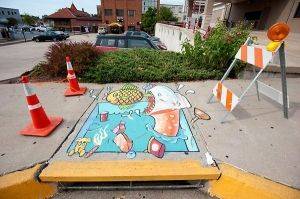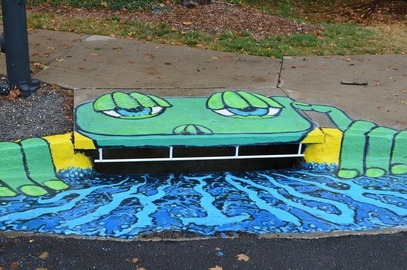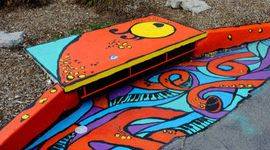At some point during my elementary school career in Champaign, a group of college students visited my starry-eyed class. They came to tell us about recycling and water conservation, but at that age I neither knew nor cared about environmentalism; I just wanted to go home and build things out of Legos. But tell us they did, and the result was that, instead of feeling educated after this presentation, I felt guilty about using too much water while children in other countries starved and suffered through oppressive lifestyles.
Guilt-tripping people doesn’t call them to action, ordinarily, especially in the case of children. Thinking about recycling and water conservation became sad and depressing for elementary me to consider. I just wanted my Legos, seriously.
Luckily, Champaign-Urbana isn’t in the business of guilt tripping people, though. By the end of October, the cities hope to get our attention—not by making us feel sad about the environment—but by inspiring us with art.
Imagine you’re walking on the sidewalk. You look down at your phone to check the time because you’re not paying attention to what’s in front of you, and out of the corner of your eye you see a storm drain on the street. No big deal. But, what if that thing had a face painted on it and was looking back up at you? Well, that’s the plan in the coming months.
According to the Public Art League’s entry form:
Selected artists will create stormwater-themed murals adjacent to storm sewer inlets in order to raise awareness about stormwater management in an urban setting. The mural themes will incorporate and illustrate principals of stormwater management. The murals must also consider and reflect multi-cultural, kid-friendly, colorful, funky, and international melting-pot characteristics. As public art works, we encourage designs with an exciting, vibrant, and energetic nature.
 I spoke with Eliana Brown, Stormwater Coordinator for the U of I and coordinator ofthe upcoming storm drain mural project, and she was happy to divulge as much information as possible. “With our stormwater program, we have forty-six Best Management practices that we do to prevent pollution from going into our two receiving streams, Boneyard Creek and a tributary to the Embarras River,” she said. “The storm drain mural project falls under our public education practice.”
I spoke with Eliana Brown, Stormwater Coordinator for the U of I and coordinator ofthe upcoming storm drain mural project, and she was happy to divulge as much information as possible. “With our stormwater program, we have forty-six Best Management practices that we do to prevent pollution from going into our two receiving streams, Boneyard Creek and a tributary to the Embarras River,” she said. “The storm drain mural project falls under our public education practice.”
A few years ago, when we started our MS4 program, we used Boneyard Creek Commnuity Day to place the storm drain medallions, and we had a lot of success with that. This is kind of a next step coming out of that program—to have an even wider reach, but of course original artwork is always attention-getting. This is an issue that’s not always on everyone’s mind, but it’s an important issue, and we’re really grateful that the artist community has stepped forward and is embracing this idea too.
Some people don’t realize that storm drains go directly to the receiving streams without receiving any treatment. So it’s not uncommon to see things just thrown on the ground that could then end up in Boneyard Creek. So part of what the storm drain mural project is doing is raising the public awareness that, you know, we don’t pollute because this could go into the creek.
 The eventual effects of what we consider to be insignificant litter and trash are chronicled in a brief TED Talk that explains the effects of garbage on marine life. I was really struck by the image of a snapping turtle called Mae West, which has grown into adulthood with a plastic milk jug ring around its mid section. To think that a small piece of plastic could have such a profound effect on an animal’s life is a jarring realization. Natural habitat for snapping turtles includes Illinois, so that photo might as well have been taken ten minutes away from here.
The eventual effects of what we consider to be insignificant litter and trash are chronicled in a brief TED Talk that explains the effects of garbage on marine life. I was really struck by the image of a snapping turtle called Mae West, which has grown into adulthood with a plastic milk jug ring around its mid section. To think that a small piece of plastic could have such a profound effect on an animal’s life is a jarring realization. Natural habitat for snapping turtles includes Illinois, so that photo might as well have been taken ten minutes away from here.
See? I just guilt-tripped you with that! How does it make you feel? It feels like you’re being preached to, and that’s no fun. Now you’re sad, so let’s get back to the murals.
 Submissions for storm drain art were due by August 10. “We had a good number of artists contact us, almost fifteen,” Brown said:
Submissions for storm drain art were due by August 10. “We had a good number of artists contact us, almost fifteen,” Brown said:
Most of them are from around here, many of them are students. We asked for examples of their artwork and examples of public art if they’ve done that before. Right now they’re developing their themes and proposed designs.
Artists were also required to go through some training, which included watching that “Seas of Plastic” TED Talk and learning about the local tributaries and rivers.
Since the project is being done through a cooperation of multiple entities across both our twin cities, expect to see this artwork appear throughout the community, including two designs on campus at either end of the Boneyard Creek as it runs through the Engineering Quad between Wright and Mathews.
Inspiration came from a similar project involving storm drains in Columbia, Missouri. “The target date for the artists to start painting is the beginning of September,” Brown said. “And as they did in Columbia they’ll have sixty days to complete they’re work. The target date is approximately October 31, the same timeframe that the folks in Columbia had.”
Columbia’s storm drain project was almost identical and is detailed through a video and multiple pictures of storm drains on the city’s website.

My favorite drain from Columbia, a community that seems fairly similar to C-U, was a project by Jane Mudd. I contacted Mudd, who’s an Assistant Professor of Art at William Woods University. She found out about the project through a friend and had this to say:
Picking out the ‘right’ drain was a challenge. I ended up picking the one I did because the storm grate looked like teeth and the sewer lid an eye. So that is why I came up with the large face and hands. A creature-type image kept appearing when I looked at the storm grate from across the street. I intended for the eyes to raise up off the pavement from a certain distance away. I thought clams would make good eyelids. (Clams need clean water to thrive). The face is no one thing in particular—a creature of sorts with human hands. I wanted it to be recognized from a distance across the street…draw people over to read the word Think.
You wouldn’t want to throw trash in that guy’s mouth, would you? Again, notice the word Think scrawled into the water flowing down the drain. Mudd hopes this artwork serves as a reminder for people to think about where their dumped litter eventually goes.
I finished my conversation with Eliana Brown by asking how she wanted the project to affect the community. She replied:
Champaign-Urbana, when you think about it, you might not know that we are really that connected and important with water. We’re not like Madison; we don’t have big lakes, and we certainly don’t have a big river or anything like that here. But what most people don’t realize is that Champaign County is the headwaters to five different rivers, and what we do here actually does matter quite a bit downstream. What I hope for the project to do is raise awareness of the importance of water and keeping our water clean.








